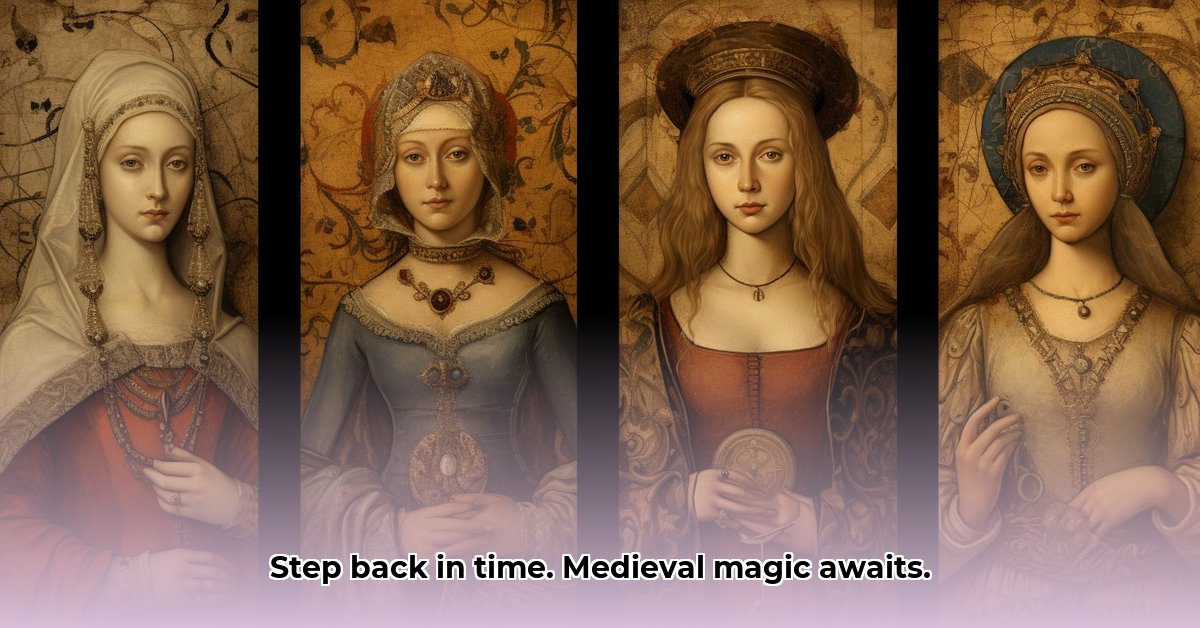Ever dreamed of stepping back in time? Imagine wandering cobblestone streets, surrounded by centuries-old buildings, breathing in the air of a bygone era. This isn’t a fantasy; it’s a reality in several incredibly well-preserved medieval cities across Europe. Learn more about medieval houses to enhance your journey. This guide explores some of the best, revealing their hidden gems and what makes each one so special. We’ll uncover fascinating history, share practical tips for your visit, and show you why these places are so important – not just for tourists, but for everyone who appreciates history and the beauty of the past. Get ready for a journey through time!
Explore Europe’s Best-Preserved Medieval Towns: A Journey Through Time
Stepping back in time is easier than you think. Europe is brimming with incredibly well-preserved medieval towns, each a captivating window into a bygone era. These aren’t just dusty relics; they’re vibrant places where history lives and breathes, blending seamlessly with modern life. Let’s embark on a journey to some of the most stunning examples, discovering their unique stories and the challenges they face in preserving their remarkable heritage.
Prague: A Fairytale Come to Life
Prague, often called the “City of a Hundred Spires,” is a magical place. Stroll along its ancient, winding cobblestone streets, surrounded by towering Gothic buildings that whisper secrets of long-ago emperors and kings. Prague Castle, a majestic fortress dominating the skyline, is a must-see. The Charles Bridge, adorned with statues, offers breathtaking views of the city. The Old Town Square, with its astronomical clock, is a hub of activity. Prague’s resilience after the devastation of World War II showcases a remarkable commitment to protecting its historical identity. A trip to Prague blends history, vibrant culture, and a modern buzz, a unique and unforgettable experience. Staying in the Old Town immerses you in the city’s charm. Consider visiting during the shoulder seasons (spring or fall) for fewer crowds and pleasant weather. Explore lesser-known gems like the Vyšehrad Castle for a quieter, more reflective experience.
Rothenburg ob der Tauber: Perfectly Preserved Charm
Rothenburg ob der Tauber in Bavaria, Germany, is a perfectly preserved medieval town seemingly plucked from a fairytale. Its iconic half-timbered houses, with their intricate wooden facades, are a photographer’s dream. Rothenburg’s strategic location on important medieval trade routes brought it prosperity, which, in turn, helped protect it from the ravages of time. Even the damage from World War II couldn’t erase its historical heart. Today, while a popular tourist destination, Rothenburg retains an authentic charm. Walk the city walls for breathtaking panoramic views, explore the Medieval Crime Museum, and enjoy a Schneeball (snowball), a local pastry. Consider a guided night watchman tour for a unique perspective on the town’s history. Visit during the Christmas Market for a truly magical experience. This town demonstrates how strategic location affects long-term preservation.
Bruges: Canals, Chocolate, and Medieval Splendor
Bruges, a charming town in Belgium, is a captivating blend of canals and medieval architecture. Its well-preserved buildings, many dating back to the Middle Ages, showcase a unique mix of Gothic and Flemish styles. The canals, once vital trade routes, are now picturesque waterways, perfect for a leisurely boat ride. Bruges flourished as a major trading center, its wealth evident in its grand and elegant buildings. Visit the Markt (market square), climb the Belfry for panoramic views, and explore the Groeningemuseum for Flemish art. Take a canal tour, sample Belgian chocolates and beer, and consider a visit to the nearby windmills. Bruges faces modern challenges; like many historical towns, it struggles to balance the needs of tourism with the crucial task of preservation. Still, its captivating medieval heart remains largely intact.
Mont Saint-Michel: A Fortress on a Tidal Island
Mont Saint-Michel in Normandy, France, has a truly unique location: a tidal island! This dramatic setting adds to its undeniable allure. Its abbey, a stunning example of Gothic architecture, reigns supreme over the landscape. Consider its strategic importance – a natural fortress, almost impossible to conquer. The challenges of maintaining Mont Saint-Michel are unique, focusing mainly on preserving its delicate ecosystem and managing the impact of the millions of visitors it attracts each year. It’s a breathtaking testament to how nature and human ingenuity can combine to create an extraordinary medieval town. Time your visit for low tide to walk across the bay – an unforgettable experience. Explore the abbey, wander the ramparts, and try the local omelet, Mère Poulard. Be aware of the tide schedule and wear appropriate footwear for walking on the sand.
Carcassonne: A Walled City
Carcassonne, France, is a stunning example of a fortified medieval city. Its imposing walls, towers, and ramparts offer a glimpse into a defensive stronghold from centuries past. Explore the Château Comtal, walk the ramparts, and wander the cobbled streets within the city walls. Carcassonne offers a truly immersive medieval experience. Carcassonne’s strategic location atop a hill made it an ideal defensive site. Its well-preserved fortifications showcase medieval military architecture.
San Gimignano: Towering Tuscan Town
San Gimignano, Italy, is famous for its medieval towers that dominate the Tuscan landscape. This UNESCO World Heritage site offers a unique glimpse into the architecture and life of a medieval hill town. Climb the Torre Grossa for panoramic views, sample local Vernaccia wine, and explore the Collegiata (Duomo). San Gimignano thrived in the Middle Ages due to its strategic location on the Via Francigena, a major pilgrimage route. Its towers symbolized the wealth and power of the town’s leading families.
Český Krumlov: Bohemian Beauty
Český Krumlov, Czech Republic, is a picturesque town located in the South Bohemia region. Its well-preserved medieval architecture and stunning castle complex make it a popular tourist destination. Explore Český Krumlov Castle, wander the Old Town Square, and take a raft trip down the Vltava River. Český Krumlov’s castle is one of the largest in Central Europe, showcasing a mix of Gothic, Renaissance, and Baroque architectural styles.
The Common Threads: Preservation and the Modern World
These medieval towns share surprising similarities. Strategic location, robust defenses, and thriving economies all contributed to their survival. However, balancing preservation with the demands of the modern world, especially tourism, is a constant challenge. Careful planning is key—maintaining authenticity while meeting the needs of visitors is a continuous balancing act. Supporting local businesses, respecting local customs, and choosing eco-friendly accommodations are ways to contribute to sustainable tourism.
| Medieval Town | Key Feature | Preservation Challenge | Tourist Highlight |
|---|---|---|---|
| Prague | Gothic Architecture | Modern Development | Prague Castle, Charles Bridge, Old Town Square |
| Rothenburg ob der Tauber | Half-timbered Houses | Sustainable Tourism Management | City Walls, Christmas Market, Crime Museum |
| Bruges | Canals & Flemish Style | Over-tourism | Canals, Chocolate, Markt |
| Mont Saint-Michel | Island Abbey & Setting | Environmental Protection | Tidal Bay Walk, Abbey Views |
| Carcassonne | Fortified Walls | Maintaining Walls | Ramparts, Château Comtal |
| San Gimignano | Medieval Towers | Tower Preservation | Torre Grossa, Vernaccia Wine |
| Český Krumlov | Castle Complex | Castle upkeep | Castle, Old Town Square |
These medieval towns are more than just tourist destinations; they’re living, breathing testaments to the past. Their continued existence is a tribute to human resilience and our enduring commitment to preserving history. Each town offers a unique and unforgettable adventure, a tangible journey back in time that powerfully reminds us of the enduring legacy of the Middle Ages. They are a treasure to be discovered, cherished, and protected for generations to come.
How to Balance Tourism and Historical Preservation in Medieval European Cities
Tourism revenue significantly boosts the financial stability of historical preservation projects. These cities face complex challenges in balancing the economic benefits of tourism with the need to protect their unique charm and historical authenticity. Sustainable tourism practices and robust regulatory frameworks ensure future generations can appreciate treasured sites. Community engagement is vital.
Key Recommendations for Visitors:
- Travel during the off-season.
- Support local businesses.
- Respect local customs and traditions.
- Choose eco-friendly accommodations.
- Be mindful of your impact on the environment.
Prague: A Fairytale Balancing Act
Prague, with its iconic Charles Bridge and majestic Prague Castle, perfectly illustrates the complexities of balancing tourism and historical preservation. Its breathtaking architecture attracts millions annually. Yet, this influx presents challenges. Overcrowding threatens the delicate balance. Prague has implemented timed-entry systems for popular sites, reducing congestion and protecting the structures. The city promotes tourism to less-visited areas. Consider visiting during the shoulder seasons (spring or fall) for a more tranquil experience.
Rothenburg ob der Tauber: A Perfectly Preserved Gem
Stepping into Rothenburg is like stepping back in time. Its impeccably preserved medieval walls and charming cobblestone streets have been carefully maintained. This town skillfully leverages tourism to fund preservation efforts, proving that economic prosperity and historic integrity can coexist. Rothenburg offers unique experiences like medieval-themed dinners and guided walking tours while prioritizing preservation. This demonstrates how effective and thoughtful tourism can contribute to ongoing preservation.
Bruges: Navigating the Fine Line
Bruges, with its canals and guildhalls, epitomizes the beauty of medieval
- Uncover Timeless Ancient Greece Female Names: A Guide to Choosing the Perfect Name - August 9, 2025
- Explore Ancient Greece Artifacts: Unveiling Iconic Treasures - August 9, 2025
- Unveiling Ancient Greek Marriage: Customs & Laws Revealed - August 9, 2025
















